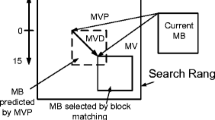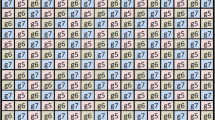Abstract
One-bit and two-bit transforms-based block motion estimation methods are introduced to reduce the computational complexity of the ME procedure by assisting a modest Boolean XOR operation, matched with lower bit-depth illustrations of image frames. However, due to some computational complexity and failure to develop the mathematical expression at the hardware level, a binary encoding mapping function technique is proposed. The mathematical expressions for the proposed method are easy to design and develop in hardware. The architecture of the proposed method is developed in Verilog HDL and implemented in Xilinx Artix-7. The results of the proposed method are checked for area, power and maximum frequency levels in different types of video frames.






Similar content being viewed by others
References
He Z, Tsui C, Chan K, Liou M (2000) “Low-power VLSI design for motion estimation using adaptive pixel truncation. IEEE Trans Circuits and Syst Video Tech 10(5):669–678
Information Technology: Coding of Audio Visual Objects—Part 2: Visual, JTC1/SC29/WG11, ISO/IEC 14496-2 (MPEG-4 Visual) (2002)
Advanced video coding for generic audiovisual services, ITU-T Recommendation H.264 (2005)
Mattavelli M, Zoia G (2000) Vector-tracing algorithm for motion estimation in large search windows. IEEE Trans Circuits Syst Video Technol 10(12):1426–1437
Al-Mualla ME, Canagarajah CN, Bull DR (2003) Reduced complexity motion estimation techniques: review and comparative study. In: Proceedings of IEEE International Conference on Electronics, Circuits and Systems, vol. 2. Sharjah, pp 607–610
Yadav SC (2016) Mapping three step search algorithm onto a systolic array processor in H.264. In: 3rd International Conference on Recent Advances in Information Technology (RAIT), pp 561–563
Jain J, Jain A (1981) Displacement measurement and its application in interframe image coding. IEEE Trans Commun 29(12):1799–1808
Sun B, Liu Z, Zhang H (2014) Novel unsymmetrical dual cross-diamond search algorithm for fast block motion estimation. In: International Conference on Audio, Language and Image Processing, pp 133–137
Reddy PR, Ijyas VT, Sameer SM (2012) A conjugate direction search algorithm for ML estimation of frequency offsets in OFDMA uplink. In: IEEE National Conference on Communications (NCC), pp 1–5
Nam KM, Kim JS, Park RH, Shim YS (1995) A fast hierarchical motion vector estimation algorithm using mean pyramid. IEEE Trans Circuits Syst Video Technol 5(4):344–351
Biswas B, Mukherjee R, Chakrabarti I (2014) An efficient VLSI architecture for motion estimation using new three step search algorithm. In: IEEE TENCON Region 10 Conference, pp 1–5
Po LM, Ma WC (1996) A novel four-step search algorithm for fast block motion estimation. IEEE Trans Circuits Syst Video Technol 6(3):313–317
Hamid NA, Darsono AM, Manap NA, Manap RA, Sulaiman HA (2014) Performance analysis of orthogonal: diamond search algorithm for motion estimation. In: IEEE International Symposium on Technology Management and Emerging Technologies, pp 306–310
Kuo CJ, Yeh CH, Odeh SF (2000) Polynomial search algorithm for motion estimation. IEEE Trans Circuits Syst Video Technol 10(5):813–818
Trudeau L, Coulombe S, Desrosiers C (2015) An adaptive search ordering for rate-constrained successive elimination algorithms. In: IEEE International Conference on Image Processing (ICIP), pp 207–211
Chen HY, Ding JJ, Lee YC (2017) Advanced one-bit transform algorithm with edge enhancement and representative feature extraction for low-complexity and accurate motion estimation. In: IEEE Region 10 Conference TENCON 2017, pp 787–792
Chia WC, Chew LW, Ang LM, Seng KP (2009) Motion estimation algorithm using one-bit-transform with smoothing and preprocessing technique. In: Huang X, Ao SI, Castillo O (eds) Intelligent automation and computer engineering, vol 52. Springer, Dordrecht
Erturk A, Erturk S (2005) Two-bit transform for binary block motion estimation. IEEE Trans Circuits Syst Video Tech 15(7):938–946
Nguyen TD, Arch-Int S, Arch-Int N (2016) An adaptive multi bit-plane image steganography using block data-hiding. Multimed Tools Appl 75(14):8319–8345
Liu S, Paul A, Zhang G, Jeon G (2015) A game theory-based block image compression method in encryption domain. J Supercomput 71(9):3353–3372
Akbulut O, Urhan O, Ertürk S (2003) Fast Sub-pixel motion estimation by means of one-bit transform. In: International Symposium on Computer and Information Sciences, ISCIS Computer and Information Sciences, pp 503–510
Bhagya Sri P, Roohi E, Siddiqui O, Muralidhar P, Rama Rao CB (2015) Filtered two-bit transform for block based motion estimation. In: IEEE International Conference on Signal Processing, Communication and Networking (ICSCN), pp 1–5
Kumar J, Kanagaraj M (2017) Enhanced TACIT algorithm based on Charl’s Table for secure routing in NoC architecture. J Comput Theor Nanosci 14(12):5680–5685
Author information
Authors and Affiliations
Corresponding author
Rights and permissions
About this article
Cite this article
Arun, A., Devaraju, M. VLSI architecture of binary encoding technique for fast motion estimation based on Hamming distances. J Supercomput 76, 4495–4507 (2020). https://doi.org/10.1007/s11227-018-2468-5
Published:
Issue Date:
DOI: https://doi.org/10.1007/s11227-018-2468-5




